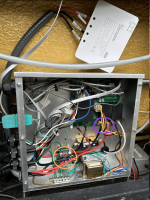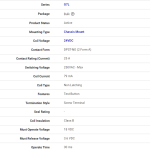- May 31, 2012
- 966
- Pool Size
- 100000
- Surface
- Vinyl
- Chlorine
- Salt Water Generator
- SWG Type
- Jandy Aquapure 1400
Why do I want to do this? I live in Toronto and I have a Jacuzzi J345 tub that is from about 2006 and it does not have any sort of timer or scheduler functionality. My electricity costs vary a lot by time of day, so I want to control when my tub’s heater is running. Overnight my costs are 2.4c/kWh. From 4-9pm the cost is 24c/kWh – 10X higher. I chose this rate plan because I have an EV and it makes it cheaper for me to charge my car, but it also lets me think about time-shifting other electrical power consumption. So, I want to heat my tub when the electricity is cheap. (Note that the costs quoted exclude indirect electricity costs like distribution and transmission fees but I am more considered about the differential between the different times and those fees are constant throughout the day).
What did I do? I put a Sonoff POWR3 smart switch between the power leads and the heater power input. Smart switch means that the tub connects via wifi to my LAN so it can be controlled by apps, an API, a home automation system, etc. So, when the switch is off the heater does not get any power. But the rest of the tub is getting power so the pumps will still run, and the control unit works. If the water temperature calls for the heater to be on the tub’s control unit thinks that it is heating the tub, but it really isn’t.
This smart switch has a power rating of 5500W which is the same as the power output of my heater – so that is cutting it close. This switch can be controlled by the eWeLink app on my phone and it can handle 240V which is what the heater uses. Having a smart switch allows you to set up sophisticated scheduling, where you can turn it on or off multiple times per day and have different schedules for different days of the week. The smart switch also monitors power consumption so you can see how much energy the heater is using. I am planning to flash the firmware of this switch to Tasmota which is an open-source firmware which will allow me to have more direct local control of the switch, and to monitor the power consumption by storing it in a database of text file. I will also then control the timer from my Control4 home automation system rather than the eWeLink app.
What exactly did I do? I disconnected the power leads that went from the power block (orange circle) to the heater power inputs on the circuit board (purple circle). I ran new 10 AWG wire from the power block up to the input of the smart switch. Then I ran two other 10 AWG wires from the output of the smart switch to the heater power input on the circuit board. I put the wires in liquidtight and used a pre-existing hole from the wiring box with a liquidtight connector to provide a waterproof seal for the wiring box.
What is left to do? I should put the switch in some sort of project box to protect it from potential water exposure. But I am worried that it might get too hot if it is in a watertight project box. I also want to put a temperature probe into the tub so that I can monitor the water temperature. Then I can keep a log of water temperature, power usage, and ambient temperature to also see how the heater’s power consumption varies with the outdoor temperature.
Aren’t I worried that the water will freeze? The main freezing worry is with the water in the pipes that go from the pumps to the heater. The tub runs the main pumps every hour or so to recirculate the water. And there is a smaller pump that continually recirculates the water. Having the main tub not be heated for 12 hours, or more, is not going to drop the water more than a few degrees and won’t significantly affect the temperature of the water in these pipes. By putting the power switch only on the heater and not on the rest of the tub system the pumps will still continue to run.

What did I do? I put a Sonoff POWR3 smart switch between the power leads and the heater power input. Smart switch means that the tub connects via wifi to my LAN so it can be controlled by apps, an API, a home automation system, etc. So, when the switch is off the heater does not get any power. But the rest of the tub is getting power so the pumps will still run, and the control unit works. If the water temperature calls for the heater to be on the tub’s control unit thinks that it is heating the tub, but it really isn’t.
This smart switch has a power rating of 5500W which is the same as the power output of my heater – so that is cutting it close. This switch can be controlled by the eWeLink app on my phone and it can handle 240V which is what the heater uses. Having a smart switch allows you to set up sophisticated scheduling, where you can turn it on or off multiple times per day and have different schedules for different days of the week. The smart switch also monitors power consumption so you can see how much energy the heater is using. I am planning to flash the firmware of this switch to Tasmota which is an open-source firmware which will allow me to have more direct local control of the switch, and to monitor the power consumption by storing it in a database of text file. I will also then control the timer from my Control4 home automation system rather than the eWeLink app.
What exactly did I do? I disconnected the power leads that went from the power block (orange circle) to the heater power inputs on the circuit board (purple circle). I ran new 10 AWG wire from the power block up to the input of the smart switch. Then I ran two other 10 AWG wires from the output of the smart switch to the heater power input on the circuit board. I put the wires in liquidtight and used a pre-existing hole from the wiring box with a liquidtight connector to provide a waterproof seal for the wiring box.
What is left to do? I should put the switch in some sort of project box to protect it from potential water exposure. But I am worried that it might get too hot if it is in a watertight project box. I also want to put a temperature probe into the tub so that I can monitor the water temperature. Then I can keep a log of water temperature, power usage, and ambient temperature to also see how the heater’s power consumption varies with the outdoor temperature.
Aren’t I worried that the water will freeze? The main freezing worry is with the water in the pipes that go from the pumps to the heater. The tub runs the main pumps every hour or so to recirculate the water. And there is a smaller pump that continually recirculates the water. Having the main tub not be heated for 12 hours, or more, is not going to drop the water more than a few degrees and won’t significantly affect the temperature of the water in these pipes. By putting the power switch only on the heater and not on the rest of the tub system the pumps will still continue to run.




